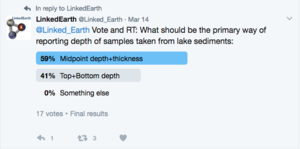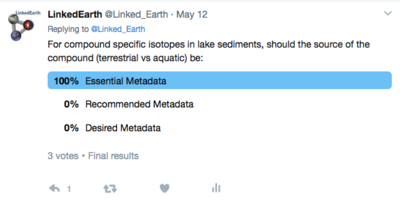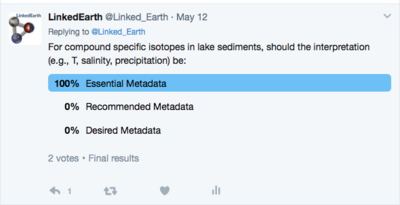Difference between revisions of "Category:Lake Sediments Working Group"
(→Sediment: Result of Twitter Poll) |
(→Sample Depth) |
||
| Line 32: | Line 32: | ||
*Top and bottom depth is more explicit and self explanatory, but typically requires an additional step to use for analysis | *Top and bottom depth is more explicit and self explanatory, but typically requires an additional step to use for analysis | ||
| − | *Mid-point depth is more typically reported, and is what is needed for most age models, but can be ambiguous | + | *Mid-point depth is more typically reported, and is what is needed for most age models, but can be ambiguous<br /> |
| + | |||
| + | |||
| + | In the case of tilted or deformed sedimentary units (for instance due to coring operations), core depths should be read at the center of the core, and information regarding the width of the subsample should be reported. | ||
| + | |||
[[File:LakeSediment Depth TwitterPoll.png|thumb|right|Results from Twitter Poll (3/14/17 to 3/21/17)]] | [[File:LakeSediment Depth TwitterPoll.png|thumb|right|Results from Twitter Poll (3/14/17 to 3/21/17)]] | ||
Revision as of 16:20, 24 June 2017
Contents
Overview
In the Linked Earth context, a working group (WG) is a self-organized coalition of knowledgeable experts, whose activities are governed herewith. This page is dedicated to the discussion of data and metadata standards for lake sediments (see this page for a definition of the lake sediment archive), and aims to formulate a set of recommendations for such a standard. Note that chronological aspects should be discussed within the Chronologies WG.
Members of 'Lake Sediments Working Group'
This working group has 15 members.
Specific tasks
Thinking about data standards for lakes is a challenging task because of the incredible diversity of observations made on this archive. To start this process, the working group will focus on developing standards for the one variable in lake sediments that all scientists rely on: depth.
After we've done this process for depth, I suggest we reach out and broaden this group to include broad expertise of different sensor and observations types. A preliminary list is presented below.
Task 1: Depth
How should we report depth?
For this discussion we recommend:
- structuring discussions around what scientific questions one would want to ask of the data
- listing essential, recommended, and desired information for:
- the measurements themselves
- any inference made from the measurements (e.g. calibration to temperature)
- the underlying uncertainties, and what those numbers correspond to (e.g. 1-sigma or 2-sigma?)
- provide an ideal data table for each type of observation, so the community knows what to report and how to report it.
- provide separate recommendations for new and legacy datasets
Sample Depth
Note: Do not edit the polls (even for typos) once voting has started as it will reset the vote counts to zero. If a change needs to be made, make an annotation above the old poll (i.e., above the poll tags) and place the new poll below the first one.
In all cases, most simply, we want to report the geometry of a sample from a core. This requires two pieces of information, typically this is either the mid-point depth and thickness, or top and bottom depth. Each has its advantages:
- Top and bottom depth is more explicit and self explanatory, but typically requires an additional step to use for analysis
- Mid-point depth is more typically reported, and is what is needed for most age models, but can be ambiguous
In the case of tilted or deformed sedimentary units (for instance due to coring operations), core depths should be read at the center of the core, and information regarding the width of the subsample should be reported.
You are not entitled to view results of this poll.
The wiki and twitter polls indicate a slight preference for mid-point and thickness
Dealing with multiple cores
Commonly, multiple cores are used in a study that each have their own depth scale ("Core Depth") and using various methods, those depths are converted to "Composite Depth", which is used for most of the scientific inference. This is important additional information. We want:
- Mid-point depth (Core Depth)
- Mid-point depth (Composite Depth)
- thickness
and ideally, we want to store the necessary information that describes the relationship between core depth and composite depth.
LacCore (and others) use splice and affine tables to accomplish that.
Add a description and discussion of splice and affine tables for discussion here.
Depth Datum
For both core depth and composite depth, we need a datum for depth. Most typically, this is the top of the sediment in each core, for core depth (where depth=0), and is the sediment surface for composite depths. Sometimes, depth from the lake (water) surface is used.
We need to either
- Describe what datum is being used for each depth measurement
OR
- choose a universal datum and force datasets to adhere
Or we could do both.
Sensors
Sensors in lakes fall into several different categories
Sediment
Several observations can be made on sedimentary sensors including:
- grain size
- mineralogy
- geochemistry
- bulk organic carbon concentrations
- bulk inorganic carbon concentrations
- bulk nitrogen concentrations
- C:N
- isotope geochemistry
- bulk organic carbon isotopic composition
- bulk inorganic carbon isotopic composition
- bulk nitrogen isotopic composition
- Compound Specific Isotopic Analysis (CSIA)
| Metadata | Essential (E)/ Recommended (R) / Desired (D) | Reason | Added by (optional) |
|---|---|---|---|
| Category: Location_(L) (Lat, Lon) | E | Location is a must | Jrichey (talk) 07:40, 24 April 2017 (PDT) |
| Property:Wgs84:Alt (L) (Depth) | E | Water depth can be useful to get an idea of diagenesis in the core. Especially for deep-sea drilling sediments, water depths can be important to assess various biogeochemical properties | Jrichey (talk) 07:40, 24 April 2017 (PDT) |
| Sample Depth | E | Positional information needed to relate the samples back to the archive | Jrichey (talk) 07:40, 24 April 2017 (PDT) |
| ChonDataTable | E for new datasets/ R for legacy datasets | The raw radiocarbon, tie points, 210Pb measurements should be made available so that age models can be updated in light of new calibration curves or new age modeling techniques | Jrichey (talk) 07:40, 24 April 2017 (PDT) |
| Compound(s) analyzed | E | e.g., n-alkanes, FAMEs, alkenones, dinosterol | Jrichey (talk) 07:40, 24 April 2017 (PDT) |
| Source of compound in sediments | R | Is this compound marine/aquatic or terrestrial in origin? | Jrichey (talk) 07:40, 24 April 2017 (PDT) |
| Isotope measured | E | e.g., ∂2H, ∂13C, ∂15N | Jrichey (talk) 07:40, 24 April 2017 (PDT) |
| Environmental Parameter CSIA is sensitive to | R | Is the CSIA sensitive to salinity, precipitation, E-P, productivity, temperature? | Jrichey (talk) 07:40, 24 April 2017 (PDT) |
Note: Do not edit the polls (even for typos) once voting has started as it will reset the vote counts to zero. If a change needs to be made, make an annotation above the old poll (i.e., above the poll tags) and place the new poll below the first one.
You are not entitled to view results of this poll.
You are not entitled to view results of this poll.
You are not entitled to view results of this poll.
Aquatic organisms
Several sensors may be found in lakes including
- Diatoms
- may contribute silicic microfossils and biomarkers
- Ostracods
- may contribute carbonate microfossils
- Algae
- may contribute biomarkers, including alkenones
- Archaea
- may contribute biomarkers, including GDGTs
- Bacteria
- may contribute biomarkers, including GDGTs
- Fish
- may contribute macrofossils, including otoliths
Terrestrial plants
Plants growing around the lake and in the catchment of the lake may contribute macro and microfossils as well as biomarkers to the sediments. Plants are the sensors of the environment and the observations include:
- Organic geochemical biomarkers:
- plant wax n-alkanes
- plant wax n-alkanoic acids
- plant wax n-alkanols acids
- plant wax terpenoids
- lignin
- Macro/microfossils
- pollen
- leaf
- wood
- charcoal
Insects
Several sensors in the air above and around lakes may leave microfossils in lake sediments, these include
- chironimid tests, these are organic microfossils
Polls
Here are polls that the group might want to consider:
References
This category currently contains no pages or media.



